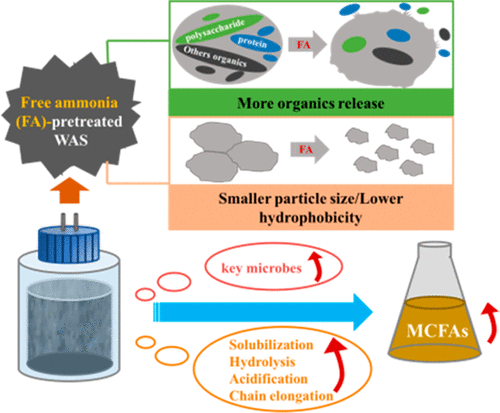当前位置:
X-MOL 学术
›
ACS ES&T Eng.
›
论文详情
Our official English website, www.x-mol.net, welcomes your feedback! (Note: you will need to create a separate account there.)
Improving Medium-Chain Fatty Acid Production from Anaerobic Fermentation of Waste Activated Sludge Using Free Ammonia
ACS ES&T Engineering Pub Date : 2021-02-02 , DOI: 10.1021/acsestengg.0c00179 Yun Wang 1 , Wei Wei 1 , Wei Wu 1 , Jing Sun 1, 2 , Qiuxiang Xu 1 , Dongbo Wang 3 , Lan Song 4 , Bing-Jie Ni 1, 2
ACS ES&T Engineering Pub Date : 2021-02-02 , DOI: 10.1021/acsestengg.0c00179 Yun Wang 1 , Wei Wei 1 , Wei Wu 1 , Jing Sun 1, 2 , Qiuxiang Xu 1 , Dongbo Wang 3 , Lan Song 4 , Bing-Jie Ni 1, 2
Affiliation

|
The utilization of waste activated sludge (WAS) to recover energy in the form of medium-chain fatty acids (MCFAs) is increasingly attractive due to the high energy density of products. However, the anaerobic fermentation process of WAS would be restricted by the poor degradability of WAS. Herein, we propose an effective approach to improving MCFA production from anaerobic fermentation of WAS using free ammonia (FA) pretreatment. The maximum MCFA production was achieved at 8.3 g of COD/L when the pretreated FA concentration was 255 mg/L, increased by 4.8-fold compared with the control (1.4 g COD/L). In addition, FA pretreatment shortened the lag phase of MCFAs production and promoted the WAS degradation compared to the control without FA pretreatment. Mechanism analysis showed that FA improved the solubilization process, which should be attributed to FA pretreatment altering the WAS properties, that is, smaller particle size and lower hydrophobicity. Moreover, FA-pretreated sludge as feedstock also promoted hydrolysis, acidification, and chain elongation processes for MCFA production, indicating that the activity of related microorganisms has been improved, which was also strongly confirmed by the microbial analysis results. On the basis of these results, a “circle economy” hypothesis that combines FA pretreatment strategy with wastewater treatment plants (WWTPs) by using easily recovered FA from anaerobic fermentation liquor was finally proposed with potential environmental and economic benefits.
中文翻译:

利用游离氨厌氧发酵废污泥提高中链脂肪酸生产
由于产品的高能量密度,利用废活性污泥(WAS)回收中链脂肪酸(MCFAs)形式的能量越来越有吸引力。但是,WAS的厌氧发酵过程将受到WAS降解性差的限制。在这里,我们提出了一种有效的方法,可通过使用游离氨(FA)预处理提高WAS厌氧发酵的MCFA产量。当预处理的FA浓度为255 mg / L时,在8.3 g COD / L时达到了最大的MCFA产量,比对照(1.4 g COD / L)增加了4.8倍。此外,与没有FA预处理的对照相比,FA预处理缩短了MCFAs产生的滞后阶段,并促进了WAS降解。机理分析表明,FA改善了增溶过程,这应归因于FA预处理改变了WAS特性,即较小的粒径和较低的疏水性。此外,FA预处理的污泥作为原料还促进了MCFA生产的水解,酸化和链延长过程,表明相关微生物的活性得到了改善,这也得到了微生物分析结果的有力证实。基于这些结果,最终提出了一种“循环经济”假说,该假说通过使用容易从厌氧发酵液中回收的FA将FA预处理策略与废水处理厂(WWTP)相结合。FA预处理的污泥作为原料还促进了MCFA生产的水解,酸化和链延长过程,表明相关微生物的活性得到了改善,这也得到了微生物分析结果的有力证实。基于这些结果,最终提出了一种“循环经济”假说,该假说通过使用容易从厌氧发酵液中回收的FA将FA预处理策略与废水处理厂(WWTP)相结合。FA预处理的污泥作为原料还促进了MCFA生产的水解,酸化和链延长过程,表明相关微生物的活性得到了改善,这也得到了微生物分析结果的有力证实。基于这些结果,最终提出了一种“循环经济”假说,该假说通过使用容易从厌氧发酵液中回收的FA将FA预处理策略与废水处理厂(WWTP)相结合。
更新日期:2021-03-12
中文翻译:

利用游离氨厌氧发酵废污泥提高中链脂肪酸生产
由于产品的高能量密度,利用废活性污泥(WAS)回收中链脂肪酸(MCFAs)形式的能量越来越有吸引力。但是,WAS的厌氧发酵过程将受到WAS降解性差的限制。在这里,我们提出了一种有效的方法,可通过使用游离氨(FA)预处理提高WAS厌氧发酵的MCFA产量。当预处理的FA浓度为255 mg / L时,在8.3 g COD / L时达到了最大的MCFA产量,比对照(1.4 g COD / L)增加了4.8倍。此外,与没有FA预处理的对照相比,FA预处理缩短了MCFAs产生的滞后阶段,并促进了WAS降解。机理分析表明,FA改善了增溶过程,这应归因于FA预处理改变了WAS特性,即较小的粒径和较低的疏水性。此外,FA预处理的污泥作为原料还促进了MCFA生产的水解,酸化和链延长过程,表明相关微生物的活性得到了改善,这也得到了微生物分析结果的有力证实。基于这些结果,最终提出了一种“循环经济”假说,该假说通过使用容易从厌氧发酵液中回收的FA将FA预处理策略与废水处理厂(WWTP)相结合。FA预处理的污泥作为原料还促进了MCFA生产的水解,酸化和链延长过程,表明相关微生物的活性得到了改善,这也得到了微生物分析结果的有力证实。基于这些结果,最终提出了一种“循环经济”假说,该假说通过使用容易从厌氧发酵液中回收的FA将FA预处理策略与废水处理厂(WWTP)相结合。FA预处理的污泥作为原料还促进了MCFA生产的水解,酸化和链延长过程,表明相关微生物的活性得到了改善,这也得到了微生物分析结果的有力证实。基于这些结果,最终提出了一种“循环经济”假说,该假说通过使用容易从厌氧发酵液中回收的FA将FA预处理策略与废水处理厂(WWTP)相结合。



























 京公网安备 11010802027423号
京公网安备 11010802027423号